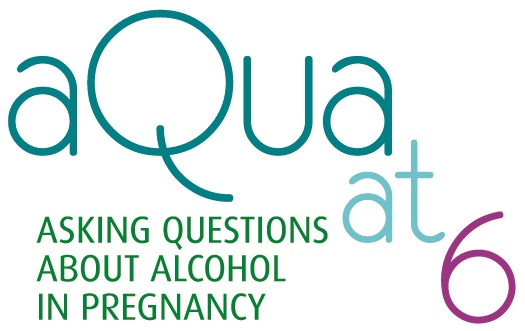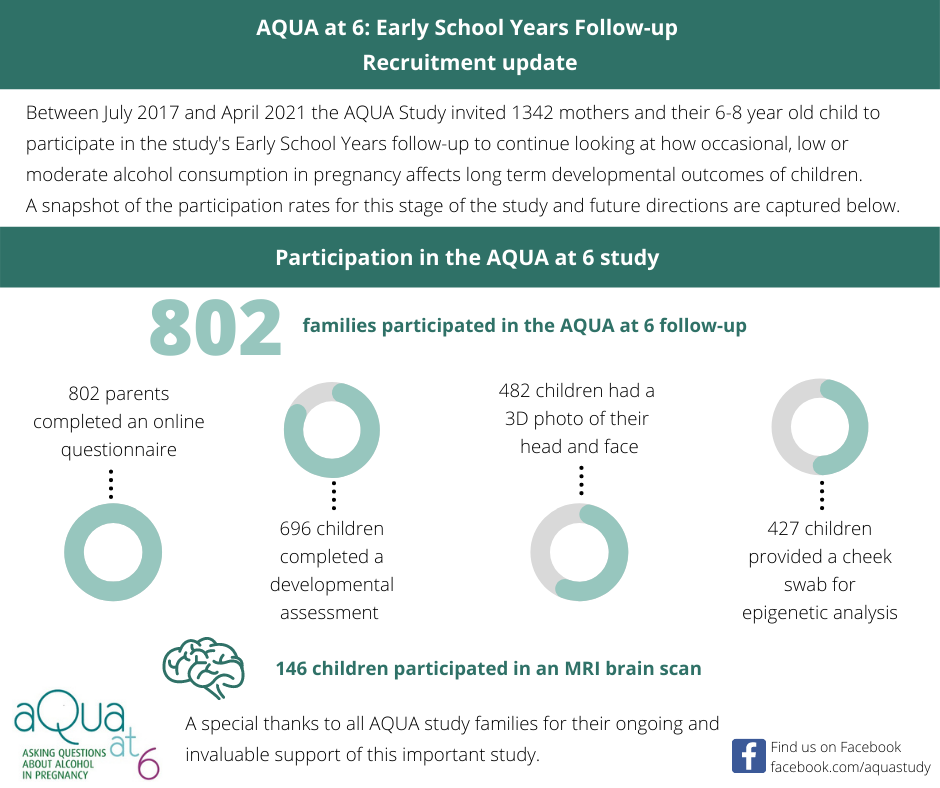AQUA Study Stage 2: Early School Years (AQUA at 6)
What is AQUA at 6?
 The children in the AQUA study turned six during 2018 and 2019, and we followed their development as they began their journey through school. This stage of the study is called the AQUA Early School Years Follow-up, or AQUA at 6 for short.
The children in the AQUA study turned six during 2018 and 2019, and we followed their development as they began their journey through school. This stage of the study is called the AQUA Early School Years Follow-up, or AQUA at 6 for short.
We know that many aspects of the mother's pregnancy, the child's early health and their family environment influence a child's learning and behaviour, especially in the early years. We did not find any developmental problems at age 2 years related to alcohol use in pregnancy in the many children we assessed. However, early development is not always a good predictor of later development. It was critical to assess this unique group of children again once they had started school.
The commencement of school is a time when children develop complex social, academic, and physical abilities. For example, they learn to fit in with their peers and a classroom routine, and literacy and numeracy skills mature.
The purpose of AQUA at 6 was to gather detailed information on 6-8-year-old children about how they were coping with these new demands on their development. We again looked at whether occasional, low or moderate alcohol consumption in pregnancy is associated with any problems in the health and development of young children. For this, the children did an assessment with a psychologist, who looked at the child's thinking, reactions, learning, early academic achievement, communication and body movement.
We were also interested in facial development and 482 children had a 3D photograph taken of their face and head. 146 children had a brain MRI to investigate possible brain characteristics.
427 children provided a cheek swab. Cheek swabs collect some of the loose cheek cells from inside the mouth and are an easy way to get DNA for testing. We will use this DNA to study epigenetics. Epigenetics is a process that controls if genes are activated or switched off. This is important in growth and development. New research shows that epigenetics is an important reason alcohol influences children's development differently.
We also linked information from developmental assessments to the Australian Early Development Census (AEDC) for 529 children who attended their Foundation year (Prep) in 2018. The AEDC is a teacher-rated population measure of early child development and allows for real-life comparison to assessments done in the research environment. Findings will help to understand if potential developmental problems associated with low-to-moderate alcohol exposure are detectable using standard population-level measures, such as those in the early school environment.
Participation in AQUA at 6
Information for families considering taking part
Here is a video we sent to our families to show them what taking part would involve. This really helped the children to understand what the day would look like.
What families told us about their experience
Between December 2018 and April 2019, we surveyed 50 mothers of children who did the AQUA at 6 assessment and 3D photo. This is because during discussions with families about participating in the study, some expressed concern about the time to do the assessment.
The survey showed that 82% of mums surveyed agreed that the day went more quickly than expected and all were comfortable keeping themselves busy while their child attended the assessment. Mothers also told us that their child enjoyed the activities. Depending on their nature, children most enjoyed the physical activities, such as throwing and catching, or the numbers and block games or just using the iPad for the various tests.
Here are some comments from mothers who took part in the survey:
"My child loved the activities. I got to have some 'me' time."
"My child enjoyed herself and I enjoyed that!"
"My child enjoyed getting lots of attention! Had fun with challenges."
"My child said it was 'better than school'."
Recruitment process
Below is an infographic explaining the recruitment process. Please contact us if you have questions.

Findings
We are currently analysing all the data collected and findings will soon be published.
See our findings so far in AQUA Study Stage 1: Pregnancy to 24 months.
AQUA at 6 funding
AQUA at 6 is funded by the National Health & Medical Research Council for 2018-2021.
Additional funding for data linkage to the AEDC was received and has been partly funded by the Gourlay Charitable Trust.
Contact us
AQUA Study
Murdoch Children's Research Institute
Reply Paid 907
Parkville VIC 3052
Phone: +61 03 8341 6370
Fax: +61 03 8341 6212
Email:
show email address
Facebook: AQUA Study
Keep in touch
If you are taking part in the AQUA study and your contact details have changed, please let us know.
Provide feedback
If you have any feedback about being in the study that you would like to pass on, we would be very interested to hear from you.
